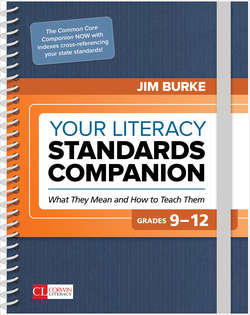Читать книгу Your Literacy Standards Companion, Grades 9-12 - Jim Burke - Страница 102
На сайте Литреса книга снята с продажи.
Common Core Reading Standard 4: What the Teacher Does
ОглавлениеTo have students interpret words and phrases as they are used in a text, do the following:
Direct students’ attention to the words, phrases, and other details (captions, diagrams, images) in a sentence and those around it. Point out the ways authors add details to clarify the meaning of words: definition clues such as explanations, synonyms, phrases, and clauses; restatement of the word or phrase (e.g., In other words); contrast or antonym clues that help define what a word means by using words that mean the exact opposite; other clues such as typography, proximity to images, and the author’s general tone.
Tell students that not all words can be understood through context clues; help them see where context clues can confuse.
Complete a think-aloud while reading to the class to show how you puzzle out a word or phrase using syntactic, semantic, typographic, etymological, and other types of information to decipher words.
To have students determine the figurative and connotative meaning of words, do the following:
Identify with students figurative language or words with other connotative meanings; then have them determine the literal or denotative meaning of those words; then ask them to determine, in light of how the words are used in this context, the figurative or connotative meaning.
Direct students’ attention to words used figuratively (simile, metaphor, analogy, euphemism, and pun) and ask them to determine a word’s meaning and explain how its use affects the meaning of other words around it or contributes to the meaning of the larger text.
Have them assess whether a set or series of words used figuratively has a unifying theme (e.g., they are all related to gardens, sports, the law) and, if they do, what it is and how that set of thematic words adds meaning to the text.
To have students analyze the cumulative impact of word choice on meaning and tone, do the following:
Complete a think-aloud as you read through a text, noting the author’s use of certain words that combine with others (through sound, imagery, meaning, or stylistic or rhetorical effect) to add meaning or serve some other purpose (e.g., to reinforce a theme).
Direct students to highlight, code, or otherwise indicate (by alternately circling, underlining, or putting dotted lines under words) those words or phrases that are connected; ask them then what conclusions they can draw from the patterns, connections, or general use of words about their meaning.
Provide students a list of words or phrases with a common theme left unstated; ask them what the words have in common and how that relates to the text from which they come.
To have students determine the meaning of discipline-specific words, symbols, terms, do the following:
Show students how to make use of any textual features—sidebars, captions, typography (is the word in bold and thus in the glossary), diagrams, footers, or glossaries in the chapter or in the appendix—available in the textbook.
Teach students, when appropriate, the root words or etymology of certain subject-specific words (bio = life, ology = study of) as part of the study of any discipline.
To have students analyze how authors use and refine the meaning of key terms, have students do the following:
Cut and paste the whole text into www.wordle.net to see which words are used most frequently in the text; then choose those which are most important to the text or topic and see how they are used over time and how their meaning shifts.
Access a text, if possible, in a digital form so you can use the search feature to find all the instances of a word; then you can examine with students its use in those different contexts and trace how its meaning changes from beginning to the end of the text.
To help your English Language Learners, try this:
Use these words as often as possible, speaking them aloud so students hear them used in context and pronounced correctly.
